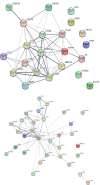This is a preprint.
Novel Approach to Exploring Protease Activity and Targets in HIV-associated Obstructive Lung Disease using Combined Proteomic-Peptidomic Analysis
- PMID: 38883770
- PMCID: PMC11177978
- DOI: 10.21203/rs.3.rs-4433194/v1
Novel Approach to Exploring Protease Activity and Targets in HIV-associated Obstructive Lung Disease using Combined Proteomic-Peptidomic Analysis
Update in
-
Novel approach to exploring protease activity and targets in HIV-associated obstructive lung disease using combined proteomic-peptidomic analysis.Respir Res. 2024 Sep 10;25(1):337. doi: 10.1186/s12931-024-02933-9. Respir Res. 2024. PMID: 39256809 Free PMC article.
Abstract
Background: Obstructive lung disease (OLD) is increasingly prevalent among persons living with HIV (PLWH). However, the role of proteases in HIV-associated OLD remains unclear.
Methods: We combined proteomics and peptidomics to comprehensively characterize protease activities. We combined mass spectrometry (MS) analysis on bronchoalveolar lavage fluid (BALF) peptides and proteins from PLWH with OLD (n=25) and without OLD (n=26) with a targeted Somascan aptamer-based proteomic approach to quantify individual proteases and assess their correlation with lung function. Endogenous peptidomics mapped peptides to native proteins to identify substrates of protease activity. Using the MEROPS database, we identified candidate proteases linked to peptide generation based on binding site affinities which were assessed via z-scores. We used t-tests to compare average forced expiratory volume in 1 second per predicted value (FEV1pp) between samples with and without detection of each cleaved protein and adjusted for multiple comparisons by controlling the false discovery rate (FDR).
Findings: We identified 101 proteases, of which 95 had functional network associations and 22 correlated with FEV1pp. These included cathepsins, metalloproteinases (MMP), caspases and neutrophil elastase. We discovered 31 proteins subject to proteolytic cleavage that associate with FEV1pp, with the top pathways involved in small ubiquitin-like modifier mediated modification (SUMOylation). Proteases linked to protein cleavage included neutrophil elastase, granzyme, and cathepsin D.
Interpretations: In HIV-associated OLD, a significant number of proteases are up-regulated, many of which are involved in protein degradation. These proteases degrade proteins involved in cell cycle and protein stability, thereby disrupting critical biological functions.
Conflict of interest statement
Additional Declarations: No competing interests reported.
Figures



References
-
- Gingo MR, George MP, Kessinger CJ, Lucht L, Rissler B, Weinman R, Slivka WA, McMahon DK, Wenzel SE, Sciurba FC, Morris A. Pulmonary function abnormalities in HIV-infected patients during the current antiretroviral therapy era. American journal of respiratory and critical care medicine 2010: 182(6): 790–796. - PMC - PubMed
-
- Hirani A, Cavallazzi R, Vasu T, Pachinburavan M, Kraft WK, Leiby B, Short W, Desimone J, Squires KE, Weibel S, Kane GC. Prevalence of obstructive lung disease in HIV population: a cross sectional study. Respiratory medicine 2011: 105(11): 1655–1661. - PubMed
-
- Kristoffersen US, Lebech AM, Mortensen J, Gerstoft J, Gutte H, Kjaer A. Changes in lung function of HIV-infected patients: a 4.5-year follow-up study. Clinical physiology and functional imaging 2012: 32(4): 288–295. - PubMed
-
- Crothers K, Huang L, Goulet JL, Goetz MB, Brown ST, Rodriguez-Barradas MC, Oursler KK, Rimland D, Gibert CL, Butt AA, Justice AC. HIV infection and risk for incident pulmonary diseases in the combination antiretroviral therapy era. American journal of respiratory and critical care medicine 2011: 183(3): 388–395. - PMC - PubMed
Publication types
Grants and funding
LinkOut - more resources
Full Text Sources

